Indonesia Mobile Payments Market Size
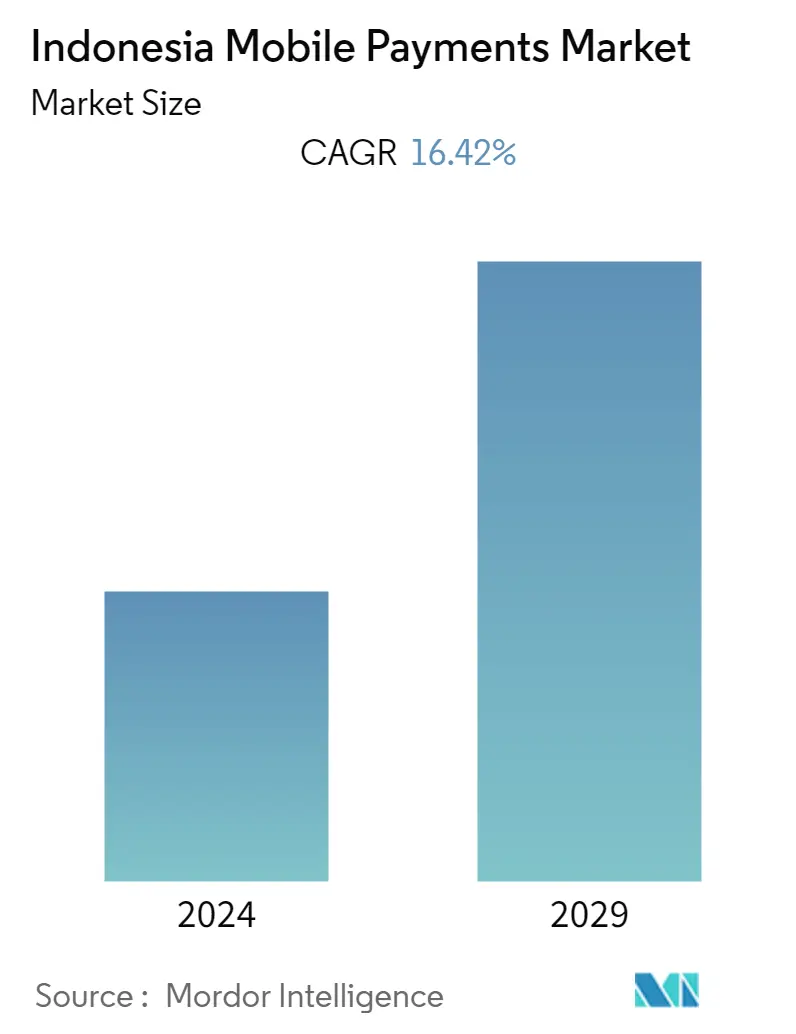
| Study Period | 2019 - 2029 |
| Base Year For Estimation | 2023 |
| Forecast Data Period | 2024 - 2029 |
| Historical Data Period | 2019 - 2022 |
| CAGR | 16.42 % |
| Market Concentration | Medium |
Major Players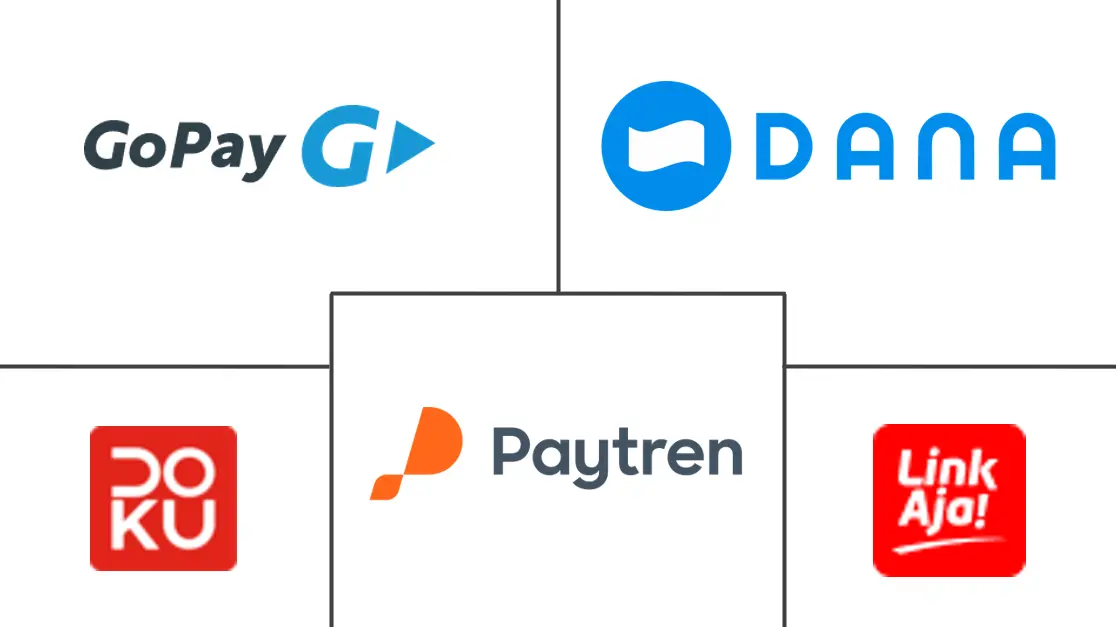
*Disclaimer: Major Players sorted in no particular order |
Indonesia Mobile Payments Market Analysis
The Indonesia mobile payments market for mobile payments is anticipated to expand at a CAGR of 29.5 percent over the projected period (2022 - 2027). The use of mobile payment systems like Gojek, GoPay S.R.O., DANA, DOKU, and LinkAja by businesses and services nationwide is progressing quickly. This trend is anticipated to persist during the projection period due to rising internet usage and the rapid expansion of online shopping.
- Mobile phones, especially smartphones, have evolved into a necessary component of a person's life as a result of the nation's economy's fast growth. Additionally, the majority of people worldwide now depend on the internet for most of their daily activities. This led to a large surge in the market for mobile payments as smartphones and internet users spread around the region. According to Bank Indonesia, access to financial technology is extensive, with over 10 million fixed-line broadband internet customers and 248.2 million users of 3G and 4G mobile phones.
- Many industry participants, like Gojek, DANA, etc., use reward systems to both retain existing mobile payment service users and attract new ones. In order to facilitate transactions through their applications, several service providers, for instance, provide scratch cards that are loaded with a specific amount. Such compensation schemes encourage customers to use mobile payment apps, which boosts the market for mobile payments.
- The market for mobile payments is expected to expand over the course of the forecast period as a result of the growing popularity of M-commerce, which entails doing online business utilizing wireless devices like smartphones. The world's most mobile-oriented area, according to App Annie's Q3 report for 2021, is Indonesia. Remarkably, Indonesian people spend 5.5 hours every day utilizing mobile apps.
- Additionally, M-commerce enables consumers to transact anywhere there is wireless internet access. Additionally, businesses like LinkAja and Paytren have already debuted their mobile commerce offerings. Customers can now instantly make in-store purchases without the hassle of swiping a card, thanks to the introduction of digital wallets like GoPay, OVO, ShopeePay, etc.
- The market for mobile payments is growing but is being constrained by rising data breaches and security problems. Additionally, due to worries about security and unlawful use of personal data, many customers are hesitant to accept the new technology.
- Customers all across the world started using digital transactions during the COVID-19 epidemic. Customers have access to digital banking systems through several banks and financial institutions. As a result, during the COVID-19 epidemic, mobile payments increased across the nation. As seen in the Indonesian Batik small- and medium-sized enterprise (SME) sector, which was experiencing a shift in modern transaction methods, particularly since the coronavirus outbreak spread in Indonesia, interest in m-payment was growing among consumers and traders because it was a contemporary alternative to debit and credit cards.
Indonesia Mobile Payments Market Trends
This section covers the major market trends shaping the Indonesia Mobile Payments Market according to our research experts:
Rise in e-Wallet Platforms Drives the Market
- Consumers in Indonesia are highly open to new offerings in the digital economy. The market for fintech goods is expanding in Indonesia, as seen by the growth in the volume of transactions and the number of companies. According to Bank of Indonesia statistics, digital banking transactions in Indonesia increased 47% YoY through November to 3,877 trillion rupiahs (USD 269.52 billion), mostly as a result of the current COVID-19 pandemic's global expansion.
- In the third quarter of 2021, the value of payment transactions made using electronic money and digital banking increased by 52.5 percent (YoY) and 60.7 percent (YoY), respectively. The development and simplicity of digital payment systems, the acceleration of digital banking, and the growing public preference for online shopping all contribute to the rapid growth of digital transactions.
- Further, the Indonesian government authorities have authorized 41 licensed e-Wallet systems as of February 2020; in October 2019, SamsungPay joined the Indonesian market, which was a notable development for a foreign fintech company. Nearly half of Indonesia's population-102 million people-grew from 64 million to 102 million digital customers between 2017 and 2018. Online shopping is expected to expand 3.7 times from 13.1 billion USD in transactions in 2017 to 48.3 billion USD in 2025 due to the rise of digital customers.
- In the previous two years of 2021, the number of e-wallet apps held by internet-based businesses climbed by 50%. GoPay, DANA, Paytrend, and DOKU are four of these businesses that are in the top 10 e-Wallet apps in Indonesia. Three-quarters of Indonesia's 260 million people still lack access to basic financial services. Therefore the country's regulator, the Financial Services Authority (OJK), promoted this expansion to strengthen the economy of the nation. Jenius from BTPN, Go Mobile by CIMB from CIMB, and Sakuku from BCA are three of the top 10 most downloaded e-Wallet apps that are owned by banks.
- Also, some overseas e-Wallet providers have expressed interest in the digital payment sector in Indonesia. WeChatPay, AliPay, and WhatsApp Pay are keeping an eye on market growth. Any international competitor looking to break into the Indonesian e-Wallet industry must collaborate with a regional bank known as Buku 4 (BUKU 4 - Bank Umum Kegiatan Usaha). Seven banks in Indonesia are now designated as BUKU 4 banks: BNI, Mandiri, BRI, BCA, CIMB Niaga, Bank Danamon, and Bank Panin for cross-border e-Wallets through the Bank of Indonesia. The usage of Indonesian money with QRIS and compliance with the Standardization of Open Application Programming Interface are requirements for foreign-invested e-Wallet systems.
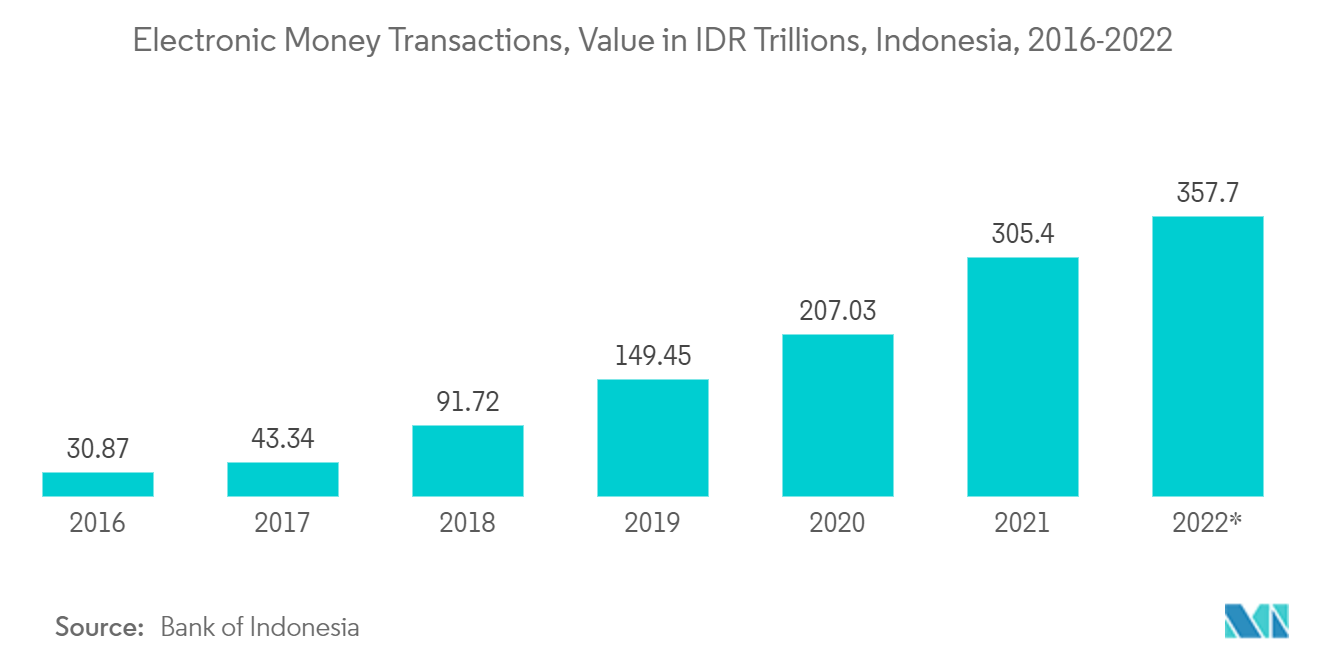
Retail to Hold Significant Share
- Under the theme "Payment System Digital Transformation to Accelerate National Economic Recovery," Bank Indonesia virtually introduced the Bank Indonesia Fast Payment (BI-FAST) system. For the purpose of facilitating retail payment transactions for the general public, Bank Indonesia has established the BI-FAST payment system infrastructure, which is accessible through apps given by the payment system industry. In accordance with each bank's strategy to provide its clients with a variety of payment methods, BI-FAST is being gradually pushed out to its consumers.
- According to BI statistics, digital banking transactions in Indonesia increased 47% y/y through November to 3,877 trillion rupiahs (USD 269.52 billion), mostly as a result of the current COVID-19 pandemic's global expansion.
- As compared to the existing interbank money transfer fee of 6,500 rupiahs (46 cents) for each transaction, the new BI-Fast system offers consumers real-time, secure money transfers of up to 250 million rupiahs (about USD 170,000) for a maximum cost of 2,500 rupiahs (17 cents) per transaction.
- The most widely used fintech service in Indonesia is electronic money, sometimes known as e-Wallet payments. This is followed by web-based investing and pay-later services. As Indonesia moves closer to a cashless society, electronic money transactions in the country's retail sector increased by 173 percent in January 2020 compared to the same month the previous year. Nonbank fintech dominated the market, where e-money transactions were IDR 15.8 trillion. The biggest digital transactions in Indonesia are in retail (28%), online transportation (27%), meal ordering (20%), e-commerce (15%), and bill payments (7% ).
- Especially among MSME and retail merchants, the national and regional initiatives to spread Quick Response Code Indonesian Standard (QRIS) have advanced the digital economy and finance. Since its introduction in August 2019, Bank Indonesia has conducted a significant public relations effort to raise awareness of QRIS as Indonesia's only digital payment standard.
- Moreover, the value of payments made using electronic money and digital banking in Indonesia has increased significantly year over year to 58.70% (YoY) and 42.90% (YoY) and will increase to 49.06 percent (YoY) and 45.64 percent (YoY) in 2021, respectively. It is strengthened by the QR Code Indonesian Standard (QRIS) ecosystem's growth, which has surpassed the goal of 12 million merchants in 2021 and is primarily driven by a rise in Micro businesses and Small businesses.
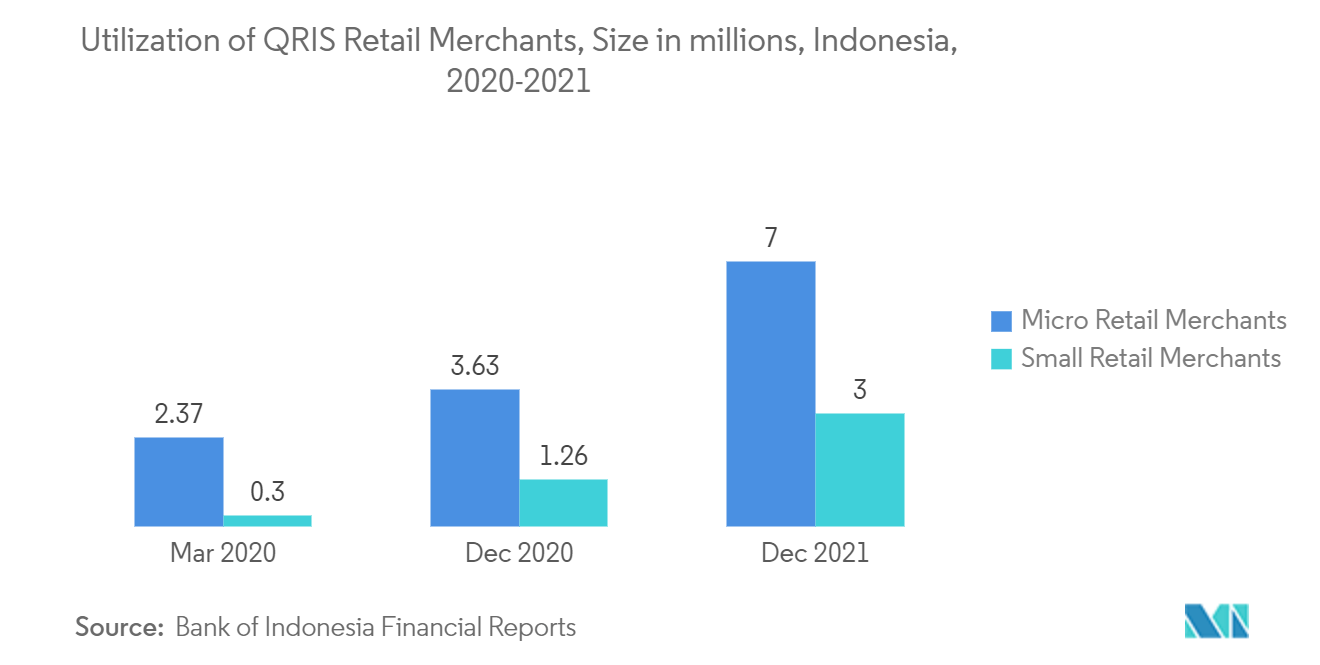
Indonesia Mobile Payments Industry Overview
- November 2021 - GoPay, and Bank Jago, an Indonesia-listed technology-based bank, announced a new service integration that will enable the Indonesian public to open a Jago bank account directly from the Gojek application. This integration between an on-demand platform and a digital bank is the first of its kind in Indonesia and will provide convenient access to digital banking for the millions of unbanked and underbanked consumers in the country.
- March 2022 - One of Indonesia's prominent conglomerates, Sinar Mas Group, invested USD 225 million in the e-wallet platform Dana. The energy and infrastructure-focused subsidiary of Sinar Mas, DSST Dana Gemilang, will invest USD 200 million in Dana, with the remaining USD 25 million coming from Bank Sinarmas. The partnership aims to have a beneficial influence on the DSST and other stakeholders' digital ecosystem growth.
Indonesia Mobile Payments Market Leaders
-
GoPay S.R.O.
-
DANA
-
DOKU
-
LinkAja
-
Paytren
*Disclaimer: Major Players sorted in no particular order
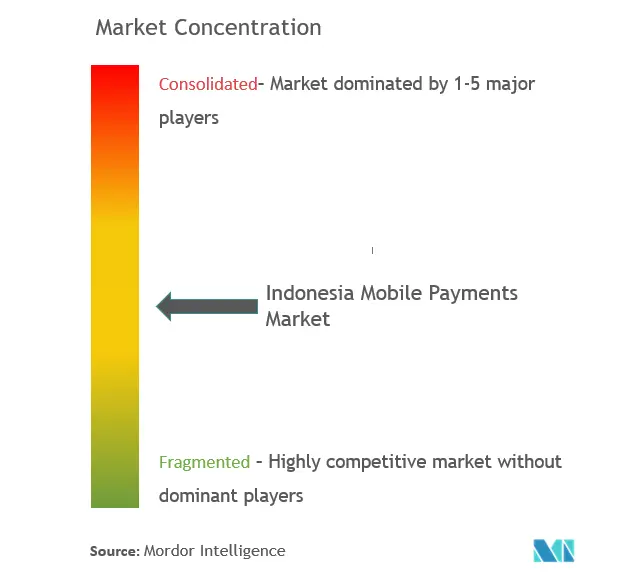
Indonesia Mobile Payments Market News
- December 2021 - Bank Indonesia launched the Bank Indonesia Fast Payment (BI-FAST) system virtually, entitled 'Payment System Digital Transformation to Accelerate National Economic Recovery.' BI-FAST is a payment system infrastructure provided by Bank Indonesia and accessible via applications offered by the payment system industry to facilitate retail payment transactions for the public. BI-FAST is being rolled out by banks to their customers gradually in line with the respective bank's plan to offer different payment channels to their customers.
- December 2021 - A strategic relationship has been established between Kaddra, a Singapore-based tech company that offers loyalty, mobile commerce, and remarketing solutions for retail and consumer brands, and DOKU, the country's prominent digital payment gateway. Through their relationship with Kaddra, they hope to use their technology to provide SMEs with the resources they need to develop cutting-edge mobile commerce at a price they can afford.
Indonesia Mobile Payments Market Report - Table of Contents
1. INTRODUCTION
- 1.1 Study Assumptions and Market Definition
- 1.2 Scope of the Study
2. RESEARCH METHODOLOGY
3. EXECUTIVE SUMMARY
4. MARKET INSIGHTS
- 4.1 Market Overview
-
4.2 Industry Attractiveness - Porter's Five Forces Analysis
- 4.2.1 Bargaining Power of Suppliers
- 4.2.2 Bargaining Power of Consumers
- 4.2.3 Threat of New Entrants
- 4.2.4 Threat of Substitute Products
- 4.2.5 Intensity of Competitive Rivalry
- 4.3 Assessment of Impact of COVID-19 on the Market
5. MARKET DYNAMICS
-
5.1 Market Drivers
- 5.1.1 Increasing Internet Penetration and Growing M-commerce Market
- 5.1.2 Increasing Number of Loyality Benefits in Mobile Environment
-
5.2 Market Restraints
- 5.2.1 Security Issues Associated with Mobile Payments
6. MARKET SEGMENTATION
-
6.1 By Type
- 6.1.1 Proximity Payment
- 6.1.2 Remote Payment
-
6.2 By End-user Industry
- 6.2.1 BFSI
- 6.2.2 IT and Telecommunication
- 6.2.3 Retail
- 6.2.4 Healthcare
- 6.2.5 Government
- 6.2.6 Media and Entertainment
- 6.2.7 Transportation and Logistics
- 6.2.8 Other End-user Industries
7. COMPETITIVE LANDSCAPE
-
7.1 Company Profiles
- 7.1.1 GoPay S.R.O.
- 7.1.2 DANA
- 7.1.3 DOKU
- 7.1.4 LinkAja
- 7.1.5 Paytren
- 7.1.6 Gojek
- 7.1.7 Sakuku
- 7.1.8 Jenius Pay
- 7.1.9 i.saku
- *List Not Exhaustive
8. INVESTMENT ANALYSIS
9. FUTURE TRENDS
** Subject To AvailablityIndonesia Mobile Payments Industry Segmentation
Mobile payment is a payment made for a product or service through a portable electronic device such as a tablet or cell phone. The study tracks the application of mobile payment based on transaction type, which is Proximity and Remote payment. The study tracks key market metrics, underlying growth influencers, and significant industry vendors, providing support for Indonesia's mobile payments market estimates and growth rates throughout the anticipated period. The study looks at COVID-19's overall influence on Indonesia's payment ecosystem.
| By Type | Proximity Payment |
| Remote Payment | |
| By End-user Industry | BFSI |
| IT and Telecommunication | |
| Retail | |
| Healthcare | |
| Government | |
| Media and Entertainment | |
| Transportation and Logistics | |
| Other End-user Industries |
Indonesia Mobile Payments Market Research FAQs
What is the current Indonesia Mobile Payments Market size?
The Indonesia Mobile Payments Market is projected to register a CAGR of 16.42% during the forecast period (2024-2029)
Who are the key players in Indonesia Mobile Payments Market?
GoPay S.R.O., DANA, DOKU, LinkAja and Paytren are the major companies operating in the Indonesia Mobile Payments Market.
What years does this Indonesia Mobile Payments Market cover?
The report covers the Indonesia Mobile Payments Market historical market size for years: 2019, 2020, 2021, 2022 and 2023. The report also forecasts the Indonesia Mobile Payments Market size for years: 2024, 2025, 2026, 2027, 2028 and 2029.
What are the key challenges faced by the Mobile Payments Market in Indonesia?
Key challenges faced by the Indonesia Mobile Payments Market are a) Regulatory hurdles b) Cybersecurity concerns c) Need for financial literacy d) Trust among potential users
Indonesia Mobile Payments Industry Report
The Indonesia mobile payments market is experiencing rapid growth, driven by the widespread adoption of smartphones and the internet, which boosts the use of e-wallets and contactless payments. This surge is supported by government initiatives aimed at creating a cashless society and improving financial inclusion, utilizing technologies like NFC, QR codes, and mobile wallets to transform transactions with unmatched convenience, speed, and security. The market's expansion is evident across various sectors including retail, transportation, food delivery, and financial services, showcasing its transformative impact and broad application in industries such as BFSI, IT, healthcare, and government.
The competitive landscape is dynamic, with numerous players innovating and forming strategic partnerships to increase their Indonesia e-wallet market share. With technological advancements and evolving consumer behaviors fueling its growth, Indonesia's mobile payments market is poised for a promising future, positioning it as a significant player in the global digital payments arena. For comprehensive insights on the Indonesia e-wallet market share, size, revenue growth, and a forecast outlook, a free report PDF download is available from Mordor Intelligence™ Industry Reports.
The market size and industry report provide vital industry information and market overview. The industry report highlights the market growth and market leaders, offering a detailed market analysis and industry outlook. The market report includes industry research and market forecast, presenting essential market data and market predictions. Market research and market segmentation are crucial for understanding the market value and industry trends. The market share and industry forecast are key components of the report example, showcasing industry statistics and market review. The global market and industry trends are also covered, providing a comprehensive market outlook.
The report PDF offers insights into the growth rate and industry analysis, emphasizing the importance of industry reports and industry research. The industry sales and industry size are detailed, along with market growth and market leaders. The market outlook and market overview are essential for understanding the market segmentation and market value. The report example and report PDF provide a thorough market review, highlighting the industry statistics and industry trends. Research companies and market data are integral to the market forecast and market predictions, ensuring a comprehensive understanding of the market dynamics.



